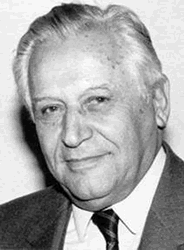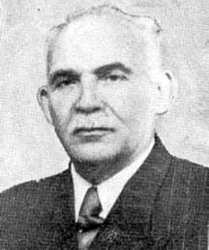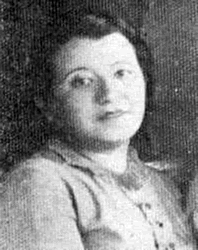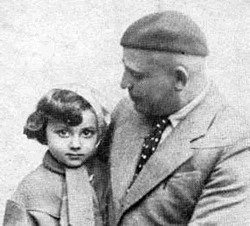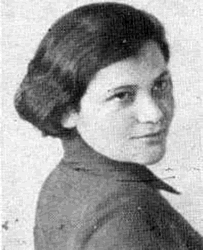#vdplk-1:
#vdplk-2:
BERNARD WAND-POLAK
b. 1916
One of ORT's greatest innovators, Bernard Wand-Polak was born in Poland and moved to France at a young age. He worked on ORT's staff in displaced person camps after the Second World War, and later took an appointment in Lyons with ORT France. Morocco was his next posting and he worked successfully to bring young Jewish boys and girls out of the mellah and into vocational training and the modern world.
After a period with ORT Israel, where he was responsible for establishing apprenticeship centres for training youngsters on the factory floor as well as in the classroom, Wand-Polak was made Director of ORT Latin America. It was here that he made his greatest impart.
Wand-Polak was responsible for ORT's innovative Creative Education programme, which introduced science and technology to very young pupils. Within the Latin American programme, supported substantially by Women's American ORT, the Jewish communities of Argentina, Brazil, Chile, Uruguay, Paraguay and Mexico benefited from a substantial Jewish and general education, served by a fine teaching staff trained in the Nathan Gould Institute in Buenos Aires.
Photo from the book "Facing the future. ORT: 1880 - 2000", World ORT, 2000
Flour grounding mill, Electricity
and the first Cinema in Volozhyn
by Mihal Vand Polak
Translated by Moshe Porat
I came from Olshan, my birth town to Volozhyn in 1910. I was married to Ester-Etl, Yohanan Rudenski's daughter. My father in law was an important flax merchant. The goods, he dealt with, was sold far away and his business even extended to Germany.
On business trips to Germany he would always “hunt” for modern gadgets. He brought us from abroad some “western culture”. Among the other novelties he brought in Volozhyn a, pendant from the ceiling, kerosene lamp. It was a very important innovation. The common lighting device was the “kournik”, a can with a cord threaded through a tube. This lamp was very economizing, because it consumed small amounts of fuel.
At those times also matches were extremely scarce. Instead of it people used glowing coals, which were guarded guarded under ash at the oven rim. To make fire we had to reveal the coals from the cinder and to blow at them until they burned. Often this fire creating method did not work. We would turn then among neighbors looking for a well glowing coal, so we could make a fire.
People would always carry in their pocket an iron tool, a piece of lint and a small rock. knocking the iron on the rock produced sparks, which ignited the lint and produced the vital fire. In the year 1910 the first matches were brought from the Viazma city.
I was familiar with flour grinding production. In Volozhyn did not exist such a mill. The nearest one was in Sakovshchina hamlet on the Berezina River 8 Km from town. The mill, moved by the river waterfall, belonged to Graph Tishkevitsh and was leased by Yakov Bunimovitsh. Flour grinding was involved with great difficulties. The queue to grind was very long and sometimes clients had to wait an entire week to grind their grain into flour.
In order to free the town inhabitants from this burden I decided to build a grinding mill of my own. I brought machinery from Minsk and from Germany. The equipment was quite primitive. Wood spill and sawdust served as fuel.
Yakov Bunimovitsh warned me. Building such a mill in Volozhyn will be turn in a dangerous adventure: “Du vest zah ferplontern vi a hon in a pakule” – “you will entangle yourself like a cock in a flax-bulb”.
My friend's warning did not deter me. With all my energy I carried out the project. In less than a year, the mill was ready, and began to function around the clock, day and night. Myself, I worked as the main miller.
At the end of the first year I was hit by a big disaster, the wood that was prepared for the steam heating had been swift by the springtime snow-melting flood. When the soil dried up the exposed wood was found. But the Goyim peasants claimed that it was their property, and I had to re-buy it anew. After I buyed the wood for a second time and brought it to the our courtyard, the mill could renew its function at full steam.
At the end of World War One, with the Poles conquering our area, a technological changeover occurred in Volozhyn. The first Polish starosta – district governor, was prior to the war one of Graph Tishkevitsh's employees. He was my acquaintance and aware with my knowledge and energy. He asked me to install electricity and to build a cinema. I fulfilled without delay the authorities requirements. A dynamo was installed and set in motion. Electric light was supplied, first inside the mill and thereafter to the town main parts. With time passing, most of the Volozhyn houses and streets installed electrical light . The electricity was a very important achievement; it changed the city's entire appearance.
We achieved also the starosta's second requirement. An abandoned cowshed existed in the graph's estate. I could use it free as a cinema hall. I reconditioned the building, put benches inside and installed electricity. Mr. Komay, a Jewish engineer from Vilno, controlled the overhaul works. Mr. Zvi Kerstein, also from Vilno, managed the cinema functioning.
The first projected movie was “Shulamit”. My mother in law, Sara Rudenski, asked to take her in the cinema hall to see the new wonder with her own eyes. She was convinced that behind the screen live persons and animals were acting. She yelled hysterically when she saw a two-horse coach approaching. She feared to be run over.
Returning home I found her relaxed. She referred to me with joy: “I did not know, Mihal my dear, that you are so rich, all the houses, streets, horses, carriages, slaves, counts and princesses and their luxury dressings – all that is yours?” Since that evening my mother in law respected me much more.
Mihal Vand-Polak
Born in Piesk, Volkovysk district, 1884. He was a well-known and accepted figure in Volozhyn and vicinity. In spite of the fact that he was very busy with business, he always found time for public work, helping the poor and giving donations to the Zionist movements. Vand Polak was renowned by his generous contributions and by providing the Volozhyn Haluzim (pioneers- who planned to settle in Israel as farmers) with work in his plants. He was proud for being Jew. During World War One he got arms and organized a Jewish self-defense group. During the second war, he was imprisoned by the Soviets and sent to the Goulag. Thereafter his family was expelled to Siberia. Three of his daughters Yatia, Riva, Nehama and Grand Daughter Etia remained in Volozhyn and shared the shtetl's fate. He deceased in Jerusalem in October 1966. On his tomb, beneath Mihal Vand-Polak's name, at his demand was engraved: Memory to my daughters Yatia, Riva, Nehama and their families, murdered by the Nazis in Volozhyn, May 1942.
Photos of Vand-Polak family members
Dr. Hirsh Roznsteyn, his daughter Ester and Wife Yoheved-Yatia born Vand-Polak
Riva Sheyniuk born Vand Polak
Nehama Vand Polak
Michael Vand Polack
Birth: 1884
Piesk, Va?kavysk, Hrodzyenskaya Voblasts’, Belarus
Death: 1966 (82)
Jerusalem, Israel
Immediate Family:
Son of Yaakov Vand Polack and Gitel Vand Polack
Husband of Rivka Vand Polack and Etel Vand Polack
Father of Rachel Rasia Meshorer; Nechama Vand Polack; Riva sheynukk; Yaatia Yocheved Rosenshein and Bat Sheva Shvarzberg
Brother of Khaim Vand Polack
